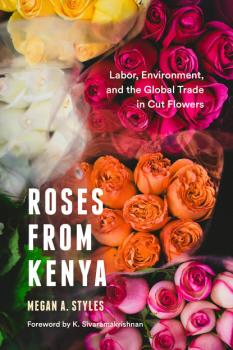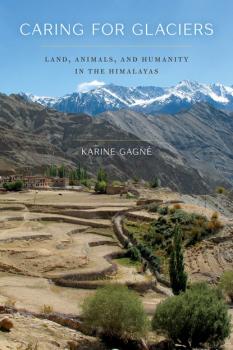ТОП просматриваемых книг сайта:
Culture, Place, and Nature
Скачать книги из серии Culture, Place, and NatureАннотация
Bovine politics exposes fault lines within contemporary Indian society, where eating beef is simultaneously a violation of sacred taboos, an expression of marginalized identities, and a route to cosmopolitan sophistication. The recent rise of Hindu nationalism has further polarized traditional views: Dalits, Muslims, and Christians protest threats to their beef-eating heritage while Hindu fundamentalists rally against those who eat the sacred cow. Yet close observation of what people do and do not eat, the styles and contexts within which they do so, and the disparities between rhetoric and everyday action overturns this simplistic binary opposition.Understanding how a food can be implicated in riots, vigilante attacks, and even murders demands that we look beyond immediate politics to wider contexts. Drawing on decades of ethnographic research in South India, James Staples charts how cattle owners, brokers, butchers, cooks, and occasional beef eaters navigate the contemporary political and cultural climate. Sacred Cows and Chicken Manchurian offers a fine-grained exploration of the current situation, locating it within the wider anthropology of food and eating in the region and revealing critical aspects of what it is to be Indian in the early twenty-first century.
Информация о книге
Автор произведения James Staples
Аннотация
Since the start of colonial gold mining in the early 1920s, the Biangai villagers of Elauru and Winima in Papua New Guinea have moved away from planting yams and other subsistence foods to instead cultivating coffee and other cash crops and dishing for tradable flakes of gold. Decades of industrial gold mining, land development, conservation efforts, and biological research have wrought transformations in the landscape and entwined traditional Biangai gardening practices with Western capital, disrupting the relationship between place and person and the social reproduction of a community. Drawing from extensive ethnographic research, Jamon Halvaksz examines the role of place in informing indigenous relationships with conservation and development. How do Biangai make meaning with the physical world? Collapsing Western distinctions between self and an earthly other, Halvaksz shows us it is a sense of place—grounded in productive relationships between nature and culture—that connects Biangai to one another as “placepersons” and enables them to navigate global forces amid changing local and regional economies. Centering local responses along the frontiers of resource extraction, Gardens of Gold contributes to our understanding of how neoliberal economic practices intervene in place-based economies and identities.
Аннотация
In the hill country of northeast Cambodia, just a few kilometers from the Vietnam border, sits the village of Tang Kadon. This community of hill rice farmers of the Jarai ethnic minority group survived aerial bombardment and the American invasion of Cambodia during the Vietnam War, only to find themselves relocated to the “killing fields” of the Khmer Rouge regime. Now back in their homeland, they have reestablished agriculture, seed by seed. Disturbed Forests, Fragmented Memories tells the story of violence and dispossession in the highlands from the perspective of the land itself. Weaving rich ethnography with the history of the Jarai and their treatment at the hands of outsiders, Jonathan Padwe narrates the highlanders’ successful efforts to rebuild their complex, highly diverse agricultural system after a decades-long interruption.Focusing on the ecological dimensions of social change and dispossession from the precolonial slave trade to the present moment of land grabs along a rapidly transforming resource frontier, Padwe shows how the past lives on in the land. An engrossing treatment of timely issues in anthropology and political ecology, this book will also appeal to readers in environmental studies, geography, and Southeast Asian studies.
Информация о книге
Автор произведения Jonathan Padwe
Аннотация
Kenya supplies more than 35 percent of the fresh-cut roses and other flowers sold annually in the European Union. This industry—which employs at least 90,000 workers, most of whom are women—is lucrative but enduringly controversial. More than half the flowers are grown near the shores of Lake Naivasha, a freshwater lake northwest of Nairobi recognized as a Ramsar site, a wetland of international importance. Critics decry the environmental side effects of floriculture, and human rights activists demand better wages and living conditions for workers.In this rich portrait of Kenyan floriculture, Megan Styles presents the point of view of local workers and investigates how the industry shapes Kenyan livelihoods, landscapes, and politics. She investigates the experiences and perspectives of low-wage farmworkers and the more elite actors whose lives revolve around floriculture, including farm managers and owners, Kenyan officials, and the human rights and environmental activists advocating for reform. By exploring these perspectives together, Styles reveals the complex and contradictory ways that rose farming shapes contemporary Kenya. She also shows how the rose industry connects Kenya to the world, and how Kenyan actors perceive these connections. As a key space of encounter, Lake Naivasha is a synergistic center where many actors seek to solve broader Kenyan social and environmental problems using the global flows of people, information, and money generated by floriculture.
Информация о книге
Автор произведения Megan A. Styles
Аннотация
Following the downgrading of the snow leopard’s status from “endangered” to “vulnerable” by the International Union for Conservation of Nature in 2017, debate has renewed about the actual number of snow leopards in the wild and the most effective strategies for coexisting with these enigmatic animals. Evidence from Pakistan and other countries in the snow leopard’s home range shows that they rely heavily on human society—domestic livestock accounts for as much as 70 percent of their diet. Maintaining that the snow leopard is a “wild” animal, conservation NGOs and state agencies have enacted laws that punish farmers for attacking these predators, while avoiding engaging with efforts to mitigate the harms suffered by farmers whose herds are reduced by snow leopards.This ethnography examines the uneven distribution of costs and benefits involved in snow leopard conservation and shows that for the conservation of nature to be successful, the vision, interests, and priorities of those most affected by conservation policies—in this case, local farmers—must be addressed. A case history of Project Snow Leopard in the mountains of northern Pakistan, which inspired similar programs in India, Bhutan, Nepal, Mongolia, Afghanistan and Tajikistan, describes how the animal’s food habits are studied, how elusive individuals are counted, and how a novel kind of “snow leopard insurance” has protected the species by compensating farmers for livestock losses. The Snow Leopard and the Goat demonstrates that characterizing this conflict as one between humans (farmers) and wildlife (snow leopards) is misleading, as the real conflict is between two human groups—farmers and conservationists—who see the snow leopard differently.
Аннотация
Throughout the Marquesas Islands of French Polynesia, forest spirits share space with ancestral ruins and active agricultural plots, affecting land use and heritage preservation. As their efforts to establish UNESCO World Heritage status continue, Marquesans grapple with questions about when sites should be preserved intact, when neglect is an appropriate option, and when deterioration resulting from local livelihoods should be accepted.In Working with the Ancestors Emily Donaldson considers how Marquesan perceptions of heritage and mana , or sacred power, have influenced the use of land in the islands and how both cultural and environmental sustainability can be achieved. The Marquesas’ relative geographical isolation and ecological richness are the backdrop for the confluence of international heritage preservation and sustainability efforts that affect both resources and Indigenous peoples. Donaldson demonstrates how anthropological concepts of embodiment, alienation, place, and power can inform global resource management, offering a new approach that integrates analyses of policy, practice, and heritage.
Аннотация
The nineteenth-century discovery of oil in the eastern Himalayan foothills, together with the establishment of tea plantations and other extractive industries, continues to have a profound impact on life in the region. In the Indian states of Assam and Nagaland, everyday militarization, violence, and the scramble for natural resources regulate the lives of Naga, Ahom, and Adivasi people, as well as migrants from elsewhere in the region, as they struggle to find peace and work.Anthropologist Dolly Kikon uses in-depth ethnographic accounts to address the complexity of Northeast India, a region between Southeast Asia and China where boundaries and borders are made, disputed, and maintained. Bringing a fresh and exciting direction to borderland studies, she explores the social bonds established through practices of resource extraction and the tensions these relations generate, focusing on peoples’ love for the landscape and for the state, as well as for family, friends, and neighbors. Living with Oil and Coal illuminates questions of citizenship, social justice, and environmental politics that are shared by communities worldwide.
Аннотация
Regional geopolitical processes have turned the Himalayan region of Ladakh, in northwest India, into a strategic border area with an increasing military presence that has decentered the traditional agropastoralist economy. This in turn has led to social fragmentation, the growing isolation of elders, and ethical dilemmas for those who strive to maintain traditional subsistence activities. Simultaneously, climate change is causing glaciers—a vital source of life in the region—to recede, which elders perceive as the consequence of a broken bond with the natural environment and the deities that inhabit the landscape. Caring for Glaciers looks at the causes and consequences of ongoing social and cultural change in peoples’ relationship with the natural environment. It illuminates how relations of reciprocity – learned through everyday life and work in the mountains with the animals, glaciers, and deities that form Ladakh’s sacred geography – shape and nurture an ethics of care. Integrating contemporary studies of affect, landscape, and multispecies anthropology, Caring for Glaciers contributes to the anthropology of ethics by examining the moral order that develops through the embodied experience of life and work in the Himalayas.
Аннотация
This first sustained ethnographic study of organic agriculture outside the United States traces its meanings, practices, and politics in two nations typically considered worlds apart: Latvia and Costa Rica. Situated on the frontiers of the European Union and the United States, these geopolitically and economically in-between places illustrate ways that international treaties have created contradictory pressures for organic farmers.Organic farmers in both countries build multispecies networks of biological and social diversity and create spaces of sovereignty within state and suprastate governance bodies.�Organic associations in�Central America and Eastern Europe face parallel challenges in�balancing�multiple identities as social movements, market sectors, and NGOs while finding their place in regions and nations reshaped by world events.�
Аннотация
The Nature of Whiteness explores the intertwining of race and nature in postindependence Zimbabwe. Nature and environment have played prominent roles in white Zimbabwean identity, and when the political tide turned against white farmers after independence, nature was the most powerful resource they had at their disposal. In the 1970s, �Mlilo,� a private conservancy sharing boundaries with Hwange National Park, became the first site in Zimbabwe to experiment with �wildlife production,� and by the 1990s, wildlife tourism had become one of the most lucrative industries in the country. Mlilo attained international notoriety in 2015 as the place where Cecil the Lion was killed by a trophy hunter.Yuka Suzuki provides a balanced study of whiteness, the conservation of nature, and contested belonging in twenty-first-century southern Africa. The Nature of Whiteness is a fascinating account of human-animal relations and the interplay among categories of race and nature in this embattled landscape.










